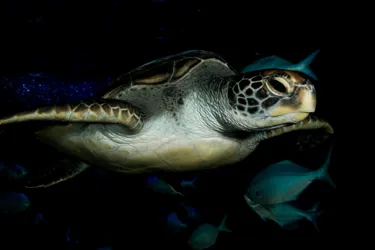Surprising Reasons Why We Need Sea Turtles
- Friday 13th December 2024
- Turtles

How much do you know about these beautiful marine creatures? Let’s go underwater to uncover some surprising sea turtle facts!
Cutting the Grass
Many sea turtles – especially the Green Sea Turtle – feed on seagrass, the vibrant green underwater grass that grows in the shallows. It’s an essential stabiliser in the ecosystem, helping to secure the loose seabed and prevent erosion. But not many animals eat seagrass, so sea turtles are essential ‘lawnmowers,’ chopping the grass down to a helpful length. This encourages it to grow thicker, not tall and spindly – a lot like the reason we mow our backyard lawns. These underwater meadows serve as breeding grounds for many of the fish species we rely upon for food. So, to protect the food chain, it’s necessary to protect sea turtles too.
Nutritious Nests
Sea turtles come ashore to lay their eggs, and in doing so, help to distribute nutrients through the sand dunes. The beach isn’t a highly fertile place, but when turtles dig their nests, they help to churn nutrients through the sand, the same way we might turn over a garden. Turtles lay eggs en masse, and naturally, not all of them will hatch. This might sound sad, but in truth, these leftover eggs provide excellent nutrients for the sand dune ecosystem. More nutrients mean stronger plants, which offer more cover and stabilise the dunes. In turn, this means more turtles can nest, and so the cycle continues.
Sayonara Stingers!
If you’re a bit scared of jellyfish, you’ll be pleased to know some sea turtles eat them! And not just a few here and there – we’re talking about tonnes of stingers! Leatherback Turtles are incredibly fond of jellies. Keeping numbers under control is important, to give fish species a chance to repopulate without getting trapped by tentacles. It’s a similar situation on coral reefs, where Hawksbill Turtles help regulate sea sponge numbers. If biting into a sponge seems like an unpleasant thought, you’re not alone. Their texture and taste turn off most predators, except the Hawksbill, whose spongey snacking keeps the coral ecosystem in balance. Just another reason to protect our sea turtles.
Rehabilitation to Release
There are seven sea turtle species: Flatback, Green, Hawksbill, Kemp’s Ridley, Leatherback, Loggerhead and Olive Ridley. To see sea turtles in real life, and learn more about their amazing lives, visit us here at SEA LIFE Kelly Tarlton’s. We’re the only place in New Zealand where sea turtles are rehabilitated and released back into the ocean. When sick or injured sea turtles are found on the NZ coast, they’re brought to us to be assessed and treated. Then they’re settled peacefully into a special rehabilitation area, to recover, and gather strength for their journey back to the ocean! On your visit, you’ll experience what’s involved in getting the turtles back home. We like to do our part to help sea turtles, and save them from extinction.
Find out more about our Turtle Rehabilitation here.
And if you’d like to meet some of the turtles that we have released back into the waters, click here!
Types of Sea Turtles and their Responsibilities
Green Turtle

Role: Seagrass Gardeners
By grazing on seagrass, green turtles prevent overgrowth, promoting healthy meadows that support marine biodiversity, stabilize the seabed, and absorb carbon dioxide.
Fun Fact! Green sea turtles can travel thousands of miles between their feeding grounds and nesting sites.
Flatback Turtle
Role: Unique Coastal Contributors
Flatback turtles play a vital role in coastal ecosystems by feeding on sea cucumbers and other invertebrates, which helps maintain sediment health and nutrient recycling in shallow waters.
Fun Fact! Unlike other sea turtles, flatbacks prefer shallow coastal waters and rarely venture into the open ocean.
Hawksbill Turtle
Role: Coral Reef Custodians
Hawksbill turtles control sponge populations, preventing them from outcompeting corals. This helps maintain vibrant, diverse reef ecosystems crucial for countless marine species.
Fun Fact! While sponges make up a significant part of their diet, Hawksbills also eat anemones, jellyfish, and other invertebrates. Their varied diet helps maintain a balanced reef ecosystem.
Kemp’s Ridley

Role: Coastal Balance Keepers
Kemp’s Ridley turtles help regulate populations of crabs and other invertebrates in coastal habitats, balancing these ecosystems and contributing to shoreline stability.
Fun Fact! The arribadas of Kemp's Ridleys, where thousands of females come ashore simultaneously to nest, are still not fully understood by scientists. This behaviour is believed to be a strategy to overwhelm predators and ensure the survival of more hatchlings.
Leatherback

Role: Jellyfish Regulators
Leatherbacks curb jellyfish blooms by consuming large numbers of them, indirectly supporting fish populations and preventing jellyfish from dominating marine food webs.
Fun Fact! They can dive to depths of over 3,000 feet, deeper than any other turtle species, and can stay underwater for up to 85 minutes.
Loggerhead Turtle
Role: Coastal Cleaners
Loggerhead turtles’ diet of hard-shelled prey like crabs and mollusks prevents overpopulation of these species, aiding in the balance of benthic (seafloor) ecosystems.
Fun Fact! Loggerheads have powerful jaws that allow them to crush hard-shelled prey like crabs and clams.
Olive Ridley

Role: Ecosystem Engineers
By feeding on crustaceans and algae, Olive Ridley turtles contribute to nutrient cycling in coastal waters, while their mass nesting events provide nutrients to beach ecosystems.
Fun Fact! After hatching, baby Olive Ridleys make an incredible journey to the ocean, guided by the natural light reflecting off the water. This journey is fraught with danger, with many hatchlings falling prey to predators.
If you'd like to learn about where to find these wonderful creatures and some more fun facts, click here!


